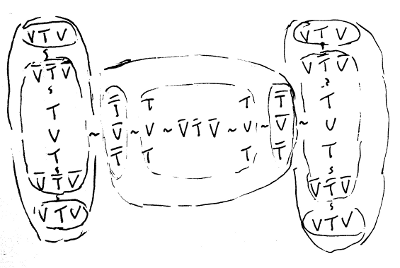Next: Rishon colour Up: Quarks and other Elementary Previous: Double-stacked I-Frames Contents
If the ultra-quarks are real, and the W and Z Boson are ultra-heavy flavours of Pions, then the next logical step would be to combine three ultra-quarks into yet another I-Frame arrangement:
 figure3-level I-Frame: ultra-quarks in a Higgs aka ultra-heavy proton
figure3-level I-Frame: ultra-quarks in a Higgs aka ultra-heavy proton
|
This particle is simply an ultra-up, ultra-down and ultra-up quark. It is, in effect, an ultra-heavy proton. If on the other hand those three quarks were an ultra-down, ultra-up and ultra-down, the combination would result in an electrically-neutral particle. Looking at the mass ratios of the Higgs to a W-Boson the figure is around 1.5, which roughly corresponds with the expectation of a 2/3s ratio (W and Z Bosons being 2 ultra-quarks, Higgs expected to be 3).
We do however have a couple of anomalies. The first is that the extended Rishon Model predicts the existence of a Higgs-0 (an ultra-heavy neutron). The second is that if the Higgs+ is actually an ultra-heavy proton, then the first immediate assumption is that it should have a spin of 1/2. However, in looking more closely at the make-up of the Higgs, there is something particularly interesting about it.
Imagine all the particles in the diagram above as being quite literally mechanically represented as physical constructs, using gimbal linkages to join them all together. Note that in the ultra-quarks there is double linkage between the outermost quarks and the innermost (central) one. In other words, ultra-quarks, by virtue of being exceptionally weird and being part-double-Pion, part I-Frame, should actually have zero "spin", in exactly the same way that Pions have zero "spin".
So, amazingly, even when little is known about the Higgs at this stage, the extended Rishon Model helps to confirm its characteristics, and even predicts the existence of an additional particle: a Higgs-0. In fact, it could well be the case that the two different experimentally observed masses for a Higgs are due to the fact that one is a Higgs+ and the other is a Higgs-0. This we surmise from the very small difference between the mass of a neutron and a proton, scaled up to that of the two Higgs observed mass measurements.
Observation: the mass ratio of the neutron to the proton is 1.001378 The mass-ratio of the two observed figures for the Higgs is 1.00559
So, rather startlingly, the extended Rishon Model not only predicts the existence of two new quarks (ultra-up and ultra-down), but also predicts the composition of the W and Z Bosons to effectively be ultra-heavy flavours of Pions, predicts the Higgs Boson to be effectively an ultra-heavy proton and also predicts the existence of a second Higgs Boson, named the Higgs-0, as being an ultra-heavy neutron.
How could any of these have been missed, after decades of research? Firstly: the Rishon Model has two types of matter, whereas all research into particle physics has taken place from the perspective of only one of those types of matter. Secondly, the Extended Rishon Model only began to fall into place once the existence of the Higgs was confirmed. Without a third level of hierarchy to confirm (from a reverse-engineering or knowledge-inference perspective) the existence of the ultra-quarks and the tau would have remained an anomaly, and against that lack of information, the identity and make-up of the W and Z could not really have been confirmed. The clue is, ultimately, in the mass ratios of all the ultra-heavy particles (including the tau).
lkcl 2016-12-29